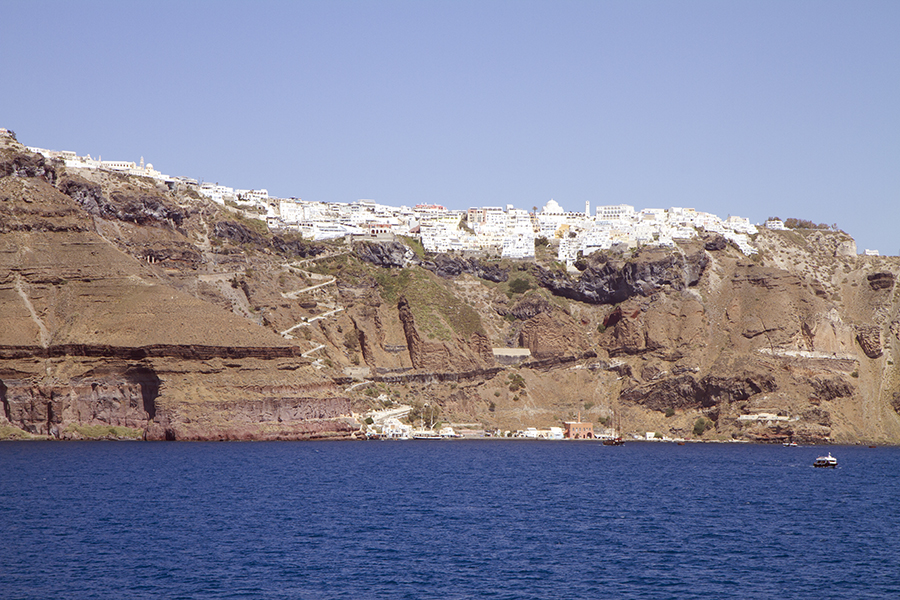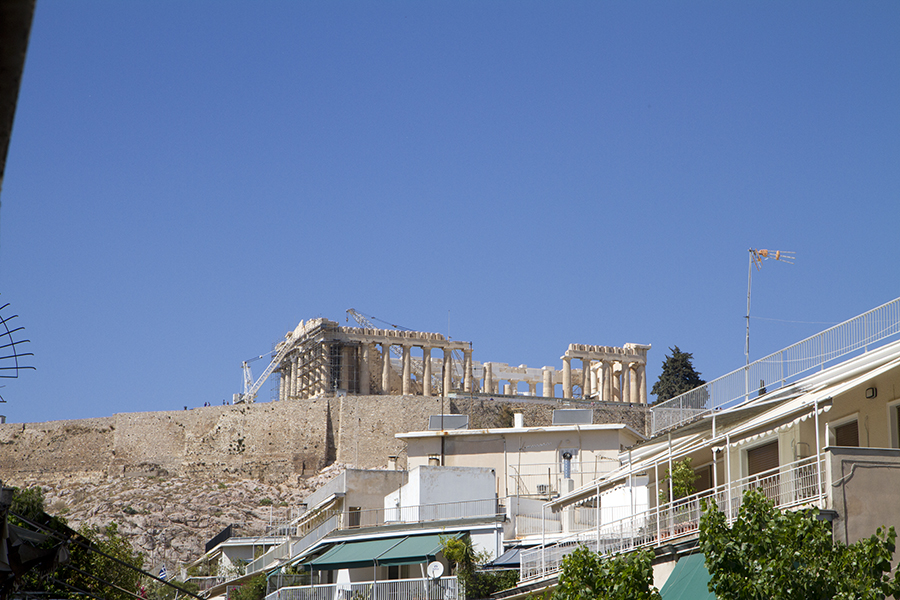In keeping with my decision to rediscover Europe now that I am back here (I almost feel like saying ‘there’), I took a week trip to Greece and started in Athens. At this time of year, I wanted a place that was a little sunnier and warmer than Belgium, and I was not disappointed.
It was already dark by the time I arrived at my hotel and checked in but I still went for a walk, to discover the town and also to look for a suitable restaurant for dinner. This is not as easy at it may seem. I like to eat early, around 19:00 to 19:30; people here do not even consider dinner before 21:00 – so how am I going to find a place favoured by locals if I am going to eat at least an hour before they will arrive? I will have to trust the guide and my instinct, I guess.
First stop is at the Temple of Olympian Zeus – it took 700 years to build it as it was started in the 6th century BC and was finished by the Roman Emperor Hadrian – it seems that he really got around after finishing the wall in Scotland! I has to look at it from the outside as the gates were closed after sunset, but it almost looked better at night than in daylight.

I walked from there through Plaka, with touristy restaurants and souvenir shops to Monastiraki, less touristy but still developing. On top of the new subway station there is an old church that seems to attract shadows …

and my first sight of the Acropolis …

I had a drink in a cafe not too far and than dinner with a “VIEW”! I was pleased with my choice of restaurant, but when I finished dinner, it was still 1/2 empty and there were mostly tourists there.
Day one was for the Acropolis. I took the subway back to Monastiraki and than walked 1/2 around the hill to find the entrance. On the foothills there are the remains of a Greek theatre and a Roman Odeon – I am not sure what is the difference between a theatre and an odeon, if anybody can help, please let me know. This is the Roman Odeon – it can almost be considered Modern Architecture in this place.
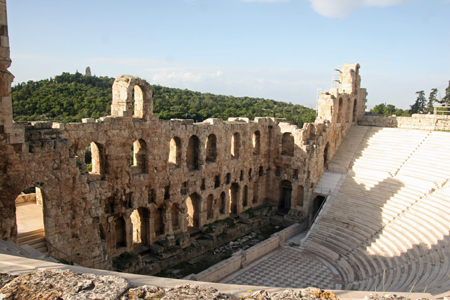
The hill in the background is PhilopappusHill and I think that will be a great place to watch sunset from, with view on the Acropolis lit by the setting sun, but also view over the water towards the sun. All I need now is a clear evening.
Climbing towards the Acropolis, I finally found the entrance – there are significant renovations, especially to the Temple of Athenan Nike, to the right of the entrance – no opportunity for a good photo though…
On the inside, the obvious monuments that everybody has seen in photos: the South portico of the Erechtheum supported by the six Caryatids (from the guide, not my description: “columns in the shape of voluptuous, drapery-clad maidens”). But seeing it live is always better than in photo.

From here, there are also beautiful views of Athens, beginning with the Temple of Olympian Zeus. In the background, half hidden by the wodded hill, you can see a Roman stadium that was renovated for and used during the 2004 Olympic games for archery.

The view towards Pyraeus is also impressive, with the Roman Odeon in the foreground

finally the Ancient Agora, built by the Greeks, not to be confused, of course, with the modern one built by the Romans – we will get to that one later…

On the right foreground is one of the early churches of Athens built so recently, probably 12th century, that it does not even appear in the guide books…
The temple in the middle is Haphaestum, one of the best preserved greek temples in Greece (they have to add that because the best preserved Greek temples are in Italy…)
With all the things to look at around the Acropolis, I almost forgot what most people think of when they consider this place: the Parthenon. I cannot say that I was disappointed as it is a beautiful building with fantastic proportions; it is also impressive that it is still in such good condition after 25 centuries, but unfortunately it is surrounded by scaffolding and heavy machinery as there is a significant renovation effort in progress.

The renovation program is sooooooooooo extensive, that it has been going on since 1983! Yes – I kid you not, and here is a sign to prove it
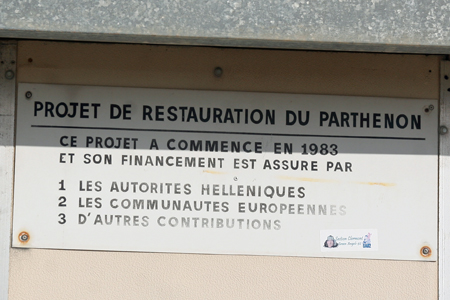
I am going to use this the next time any one complains to me about how long it takes us to do projects…. While I was there, at mid morning on a Tuesday, I did not see much activity.
Here is a closer look at the Church in the Ancient Agora

and the very beautiful Ephaestum

There is not much left of the Roman Agora – as a center piece, there is the Tower of the Winds, an octagonal tower that served as a weather vane, a sun dial and had a water clock to provide the time during the night. It was closed so I could not go inside, and I could not really see any indication that would show a sun dial but there are representations of the eight dominant winds on each side of the tower.

As I always do in cities, I did a lot of walking and came across the odd street that is nothing like what I am used to

This one is in a neighborhood that was originally built by the workers of the Parthenon. Most of them came from islands in the Aegean Sea and were home sick so they built their homes and streets around the Acropolis similar to their home villages. I has evolved since then, but there is still some of that island flavour to the area.
At 16:30, it started to rain, so I decided no to chase the sunset today, since that was to occur at 17:17.
Day two and I am on the road to Delphi. It is about three hours by bus from Athens so we get there around 11:00.
The site is really spectacular- the weather was less so, unfortunately…

Here, we discover that modern man did not invent anything. At the entrance to the ancient holy site, there is an Agora, a local market where pilgrims can buy souvenirs of their visit as well as food and anything else they may need.

The stone in the middle intrigued me as I did not associate the sign of a cross with ancient Greece. It made me think of the Knights Templar and wondered if they cam this way on the way to the Holy Land on some crusade. Our guide explained that these were recovered from local churches and placed here many years ago. She did not offer any explanation as to why this was done…
In order to get preferential treatment and get to ask your question early to the Pythia, gifts were gratefully received and stored in “Treasuries”. Those who offered the best gifts were allowed to build their treasury on the main path where others could see how generous they were (and maybe get the hint that they should do better). The Athenians had one of the best location for their treasury and it is the only one that has been completely restored.

However, the main reason to come to Delphi was the Temple of Apollo, where the Pythia resided and issued her famous ‘predictions’. Everything occurred in two underground chambers which are not open to the public. There is actually very little left of the original temple, but it was used long after the fall of the Greek Civilisation. Even the Romans used this site, except they came to see the Sybil, who still made very vague ‘predictions’.

Up above the Temple, there is a theatre, and even higher a stadium that was not accessible when I was there, unfortunately. Delphi was also the site of the quadrennial Pythjian Games, very similar to the Olympic Games, but with the addition of Music and Theatre as competitions.

As always, the view from all these venues is spectacular. In the background there are the remains of another sanctuary dedicated to Athena – two hits in one trip, considering how long it probably took to get here at the time, this was probably time sell spent…

Day three and we wake up near Meteora. It took a six hour drive from Delphi to get here and so we arrived late, and after the sun had sat. No way to tell what the site looks like. We are also a little out of town, but, we could already tell that the rock formation were near. Our first stop is just below one of the monasteries that made this area famous. There are six still in existence ad we are going to visit two of them.

A second monastery is up against the sun and therefore photos are more difficult, but it is perched just as precariously on the very top of a rocky hillock

In the distance, there is the plain and the mountains in the background are covered with the first snow of the season that feel overnight.

There are two monasteries in this next picture. One obvious on the right and one on the left that is hidden by the large rock. One tower (the ancient ‘elevator’ is just visible to the right of the left rock – that is the first monastery we will visit.

Every where the views are spectacular, aided by the gorgeous weather and the fall foliage which is just starting to change colours.

We are going to visit this monastery. There are 399 steps on the staircase added in the mid 20th century. The old entrance is the “elevator” tower visible on this picture, with a basket used, originally, for both goods and people and raised by human power – the mechanism still exists at the top of the tower.

This monastery is still used by about 8 monks – there were probably 300 at its peak but interest has been declining recently. We did not see any of the monks as they keep away from visitors. This is the top of the old tower, with the ‘basket’ still hanging in case anyone wants to use it.

The monasteries are richly decorated – here is the entrance to the monk’s mess hall

The neighbours are not that far, but it is a long way down and back up for a visit. So you better make sure you do not need a cup of salt in the middle of preparing dinner

In this next picture, there are actually four monasteries visible. One obvious in the foreground, there is a second just behind it, the third is at the very top of the rocks, to the right of the white cloud and the last is below and to the right of that one …

Still the views, with snowy mountains in the background
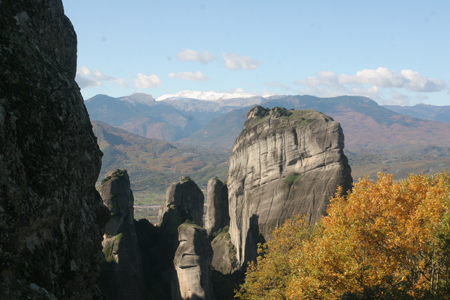
Second visit, and I am almost tempted to say more of the same, but I can live with a lot more of that same …

It is a long drive back to Athens so we have to leave early. On the way back, we stop at the site of the battle of Thermopylae, where King Leonidas and 300 Spartans almost defeated the Persian Army that was several thousand strong. They did slow them down enough that the Athenians were able to beat them later and finally stop the Persian advance. Leonidas – that makes me hungry – I wander how you go from a Spartan King to Belgian Chocolates? I am sure there is a very interesting story behind that…
On day 4 and I go for a quick trip to Pyraeus, just because I like sea and ports. There is, of course, the commercialharbour, but I am told that there are also two yacht harbours that are worth looking at – one has several good seafood restaurants that I will visit for lunch. This is the main church in Pyraeus. I went inside to visit (I think the first Greek Orthodox church that I visited)

The Greeks are known for shipping, and shipping makes money, and money buys boats and lot’s of money buys big boats … count the number of masts and divide by three and you can tell how many sailing yachts are in this picture as each has three masts! Nearby, there was an alignment with at least 20 yachts in excess of 50 m, some brand new, some real classics. There was one named Christina II – I wonder if that is one of Aristotle Onassis’ old toys?
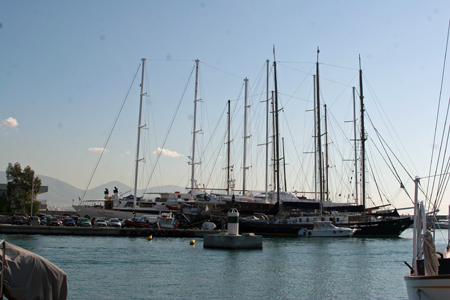
I had lunch by the water and than headed back to town. The weather stayed nice and therefore I decided to go to Philopappus Hill for sunset. I was not the only one there, but still it was not a crowd and I could therefore decide when I wanted to have people in the shot, and when I did not want any one. There is indeed a nice view of the Acropolis from here, enhanced by the light of the setting sun.

For many, it is a very romantic place and time of day. I try to be discreet, but some shots are just too good to skip.

The atmosphere was so romantic that I almost believed that this dog was flirting with me…
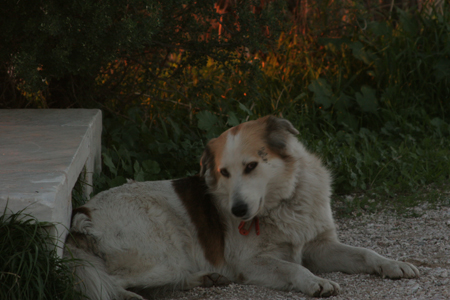
The light on the Acropolis and especially the Parthenon kept getting better and better – sunset is a rather long process since I try to arrive about 1/2 hour before the sun actually goes down. It is also unpredictable, and you only get one chance at the “perfect” light, never knowing if the next minute will be better or worst. Fortunately, I can keep trying and take regular pictures so that I am rather sure that I will eventually have a few good ones. The tough work is always afterwards, when I have 50-60 photos to look at, mostly the same but taken at different time and I have to choose the one, or two that better represent the mood of the moment.

On the other hand, there are the occasional picture that does not require much thought in the selection process. Just as I was about to take pictures, the same dog who was flirting with me decided to admire the setting sun just like everybody else and sat right in front of me. Obviously a romantic dog!

Even after sunset, my work is not done …. as the natural light fades, artificial lights everywhere take over and the transition can still be very interesting. The Acropolis looks different at this time of day

and the sky continues to change colours, some reflected into the waters of Pyraeus where boats are waiting to enter the harbour.

On my way back to the hotel, after dinner, I stopped by the Parliament Building (the former King’s Palace) and the tomb of the unknown soldier, guarded 24 hours a day by the elite members of the Evzones, with white skirts and pompoms on their shoes … at night, there is a totally different feeling to it.

Day 5, my last day, and I have to go at least to the National Archaeological Museum – the weather is just too good to go inside, but I cannot miss this one. There are the most incredible statues from the 6th and 5th centuries BC in marble and bronze, with a quality that was not repeated until the height of the Renaissance, 2000 years later. I had an indigestion of ancient vases and funeral monuments, but it was still worth it.
On the way back to the Hotel, I stopped at Lycabetus Hill, the highest in Athens. I took the cable car up, and walked down. The view is spectacular, but it pays to also look closer in. There is still wild life in the center of Athens

Could not leave this beautiful city without a last look at the Acropolis…

(1284 Page Views)




